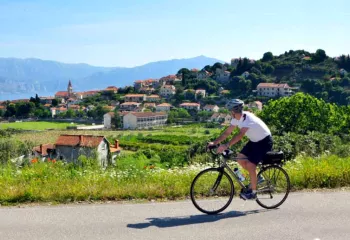The sun's shining, there's a white carpet of snow covering the ground, and the trees are heavy from the latest snowfall. Working up a sweat, I ascend a small hill and drink in the view. As far as I can see, forest covers the landscape, broken only by a small lake three kilometers away. This lake is one of many in the park, and is where I'll be eating lunch after my morning walk. Although there's nearly a meter of snow on the ground, I'm still able to enjoy the great outdoors, and get some exercise in. The reason: the snowshoes I rented from the local sports store. With these snowshoes I'm able to float on top of the snow, and travel through the landscape unimpeded. My mind wanders to my friends, many of whom are probably sitting at home, wishing the snow were gone and longing to get their regular workouts in--maybe running, maybe cycling. Meanwhile, I'm out in a winter paradise, enjoying an amazing workout. I look out at the snow in front of me. Earlier in the day, someone had walked ahead of me, breaking trail, making my journey a little easier. However, I'm not here to have it easy. I'm here to get my sweat on, and burn off some of those holiday calories. I smile as I think back to that second shortbread cookie I ate yesterday. No problem now. We've all been there: the winter blues. When the snow and the cold roll in and I can no longer ride my bike, go for a run, or paddle my kayak, I start to get a little itchy for some outdoor time. Because I need to keep fit for my summer Backroads schedule, and because I despise the gym and the cooped-up feeling I get there, I decided to start snowshoeing. Sounds a little daunting, but, trust me, it's not. If you can walk, you can snowshoe! And it's a great way to cross train for cycling during the winter! Another bonus about snowshoeing is that there is very little gear required, aside from a decent pair of snowshoes and some warm clothes. Unlike cross-country skiing, you don't need specialized boots--you can rely on your regular winter boots or shoes to keep you trucking. As a bonus, snowshoeing is cheap. A pair of snowshoes runs between $100-$200 dollars--not much more than a good pair of hiking boots. Snowshoeing has been around for thousands of years. If you've never gone snowshoeing, you probably envision large teardrop-shaped wooden frames held together with rawhide, which end up looking like giant tennis rackets. Today's technology, however, has caught up with what is one of the fastest growing winter sports in the world. Snowshoes are now made from metal or polymers with rubber and plastic straps. They're lighter and smaller than their wooden counterparts. Today's snowshoes come in all sizes depending on your weight and activity. You can even find snowshoes that are designed for the avid trail runner.
Snowshoeing is an amazing workout. If you factor in the cold weather, you can burn serious calories--up to 600 calories an hour. This is right up there with running and cycling, and will allow you to stay fit year round. And there is no need to travel far. In many cities you can strap on your snowshoes and head to local parks and golf courses. Looking for a little extra adventure? Try visiting a nearby national park for a day trip. If you're extremely keen you can even turn it in to a multi-day trip. Each year, I find myself planning a new overnight journey out into the Canadian wilderness. Don't let winter get you down--go find your local equipment store, rent a pair of snowshoes, dig out your long underwear and hit the open trail. You'll enjoy fresh air, beautiful winter scenery, and get an amazing workout that will keep you in top shape for your summer sports. No longer will your activity choices in winter be limited to spinning class or running on a treadmill. Now you can hit the open trail year round.










